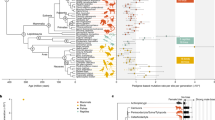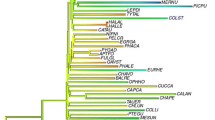Abstract
Genomes are often characterized by their genome size, recombination rate and nucleotide content. Negative correlations of recombination rate and AT-content have been reported for selected species. Here we investigate 26 completely sequenced animal genomes with respect to their genomic characteristics. After correcting for phylogenetic correlations we find significant correlations between these characters, showing that these do not evolve independently. The genomes of mammals differ when compared to other animal genomes. Correlations between AT-content and recombination rate are negative, but only for mammals. All other animals show a positive correlation for these characters. These results show that studies on the relationship between genome characteristics using single species might lead to the right conclusion, but cannot be applied as a general rule to all taxonomic groups.

Similar content being viewed by others
References
Birdsell, J. A. (2002). Integrating genomics, bioinformatics, and classical genetics to study the effects of recombination on genome evolution. Molecular Biology and Evolution, 19(7), 1181–1197.
Charlesworth, B., Langley, C. H., & Stephan, W. (1986). The evolution of restricted recombination and the accumulation of repeated DNA sequences. Genetics, 112(4), 947–962.
Felsenstein, J. (1985). Phylogenies and the comparative method. American Naturalist, 125(1), 1–15.
Fullerton, S. M., Carvalho, A. B., & Clark, A. G. (2001). Local rates of recombination are positively correlated with GC content in the human genome. Molecular Biology and Evolution, 18(6), 1139–1142.
Hagan, C. R., Sheffield, R. F., & Rudin, C. M. (2003). Human Alu element retrotransposition induced by genotoxic stress. Nature Genetics, 35(3), 219–220.
Heinrich, B. (1980). Mechanisms of body temperature regulation in honeybees Apis mellifera 2. Regulation of thoracic temperature at high air temperatures. Journal of Experimental Biology, 85(1), 73–87.
Hill, W. G., & Robertson, A. (1966). Effect of linkage on limits to artificial selection. Genetical Research, 8(3), 269–294.
Kong, A., Gudbjartsson, D. F., Sainz, J., Jonsdottir, G. M., Gudjonsson, S. A., Richardsson, B., Sigurdardottir, S., Barnard, J., Hallbeck, B., Masson, G., Shlien, A., Palsson, S. T., Frigge, M. L., Thorgeirsson, T. E., Gulcher, J. R., & Stefansson, K. (2002). A high-resolution recombination map of the human genome. Nature Genetics, 31(3), 241–247.
Kumar, S., & Nei, M. (2000). Molecular phylogenetics. Oxford: Oxford University Press.
Lenormand, T., & Dutheil, J. (2005). Recombination difference between sexes: A role for haploid selection. PLoS Biology, 3(3), 396–403.
Lynch, M. (2006). The origins of eukaryotic gene structure. Molecular Biology and Evolution, 23(2), 450–468.
Lynch, M. (2007). The origins of genome architecture. Sunderland, MA: Sinauer Ass.
Lynch, M., & Conery, J. S. (2003). The origins of genome complexity. Science, 302(5649), 1401–1404.
Martins, E. P. (2004). COMPARE, Version 4.6b. Computer programs for the statistical analysis of comparative data. (http://compare.bio.indiana.edu/).
McInerney, J. O. (1998). GCUA (general codon usage analysis). Bioinformatics, 14(4), 372–373.
Meunier, J., & Duret, L. (2004). Recombination drives the evolution of GC-content in the human genome. Molecualr Biology and Evolution, 21(6), 984–990.
Pagel, M., & Meade, A. (2004). A phylogenetic mixture model for detecting pattern-heterogeneity in gene sequence or character-state data. Systematic Biology 53(4), 571–581.
Ross-Ibarra, J. (2007). Genome size and recombination in angiosperms: A second look. Journal of Evolutionary Biology, 20(2), 800–806.
Thomas, C. A. (1971). Genetic organization of chromosomes. Annual Review of Genetics, 5, 237–256.
Vinogradov, A. E. (1998). Genome size and GC-percent in vertebrates as determined by flow cytometry: The triangular relationship. Cytometry, 31(2), 100–109.
Author information
Authors and Affiliations
Corresponding author
Electronic supplementary material
Below is the link to the electronic supplementary material.
Rights and permissions
About this article
Cite this article
Lattorff, H.M.G., Moritz, R.F.A. Recombination Rate and AT-content Show Opposite Correlations in Mammalian and Other Animal Genomes. Evol Biol 35, 146–149 (2008). https://doi.org/10.1007/s11692-008-9019-6
Received:
Accepted:
Published:
Issue Date:
DOI: https://doi.org/10.1007/s11692-008-9019-6




